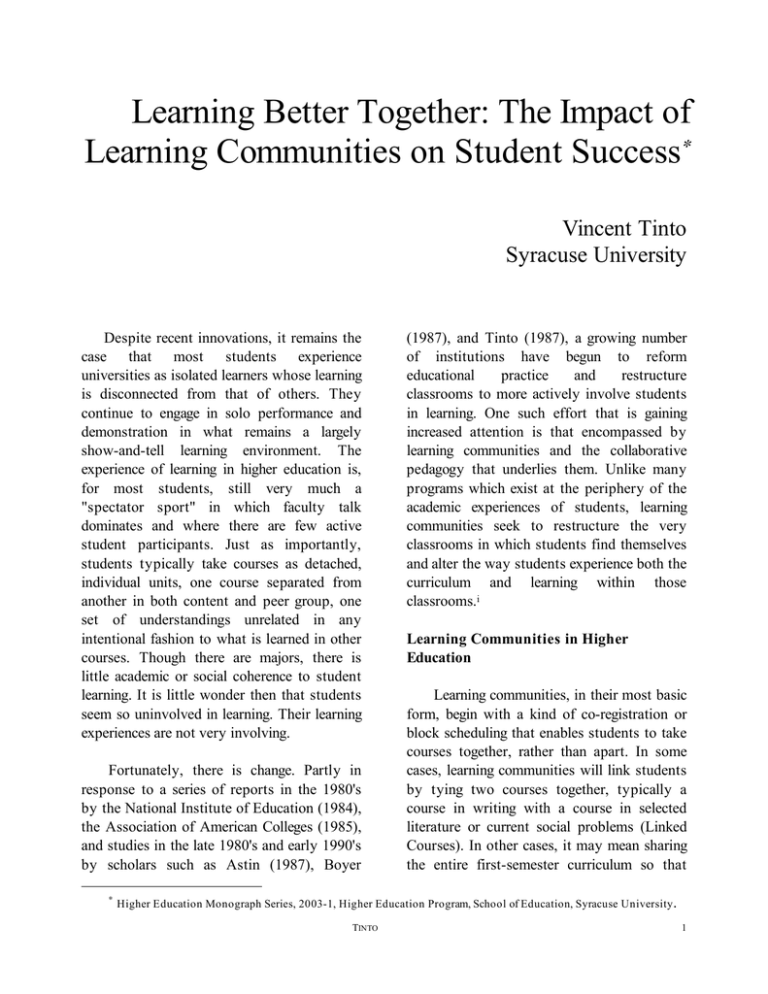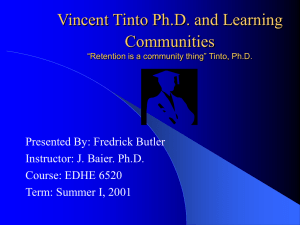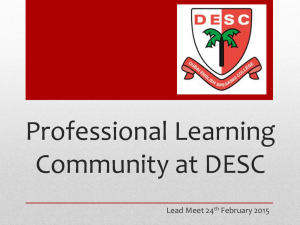Learning Better Together: The Impact of Learning Communities on
advertisement

Learning Better Together: The Impact of Learning Communities on Student Success∗ Vincent Tinto Syracuse University Despite recent innovations, it remains the case that most students experience universities as isolated learners whose learning is disconnected from that of others. They continue to engage in solo performance and demonstration in what remains a largely show-and-tell learning environment. The experience of learning in higher education is, for most students, still very much a "spectator sport" in which faculty talk dominates and where there are few active student participants. Just as importantly, students typically take courses as detached, individual units, one course separated from another in both content and peer group, one set of understandings unrelated in any intentional fashion to what is learned in other courses. Though there are majors, there is little academic or social coherence to student learning. It is little wonder then that students seem so uninvolved in learning. Their learning experiences are not very involving. Fortunately, there is change. Partly in response to a series of reports in the 1980's by the National Institute of Education (1984), the Association of American Colleges (1985), and studies in the late 1980's and early 1990's by scholars such as Astin (1987), Boyer ∗ (1987), and Tinto (1987), a growing number of institutions have begun to reform educational practice and restructure classrooms to more actively involve students in learning. One such effort that is gaining increased attention is that encompassed by learning communities and the collaborative pedagogy that underlies them. Unlike many programs which exist at the periphery of the academic experiences of students, learning communities seek to restructure the very classrooms in which students find themselves and alter the way students experience both the curriculum and learning within those classrooms.i Learning Communities in Higher Education Learning communities, in their most basic form, begin with a kind of co-registration or block scheduling that enables students to take courses together, rather than apart. In some cases, learning communities will link students by tying two courses together, typically a course in writing with a course in selected literature or current social problems (Linked Courses). In other cases, it may mean sharing the entire first-semester curriculum so that Higher Education Monograph Series, 2003-1, Higher Education Program, School of Education, Syracuse University . TINTO 1 students in the learning community study the same material throughout the semester. In some large universities such as the University of Oregon and the University of Washington, the twenty-five to thirty students in a learning community may attend lectures with 200-300 other students but stay together for a smaller discussion section, often called the Freshman Interest Group, led by a graduate student or upperclassman. In still other cases, students will take all their classes together either as separate, but linked, classes (Cluster Learning Communities) or as one large class that meets four to six hours at a time several times a week (Coordinated Studies) (See Figure I). The courses in which students co-register are not coincidental or random. They are typically connected by an organizing theme which gives meaning to their linkage. The point of doing so is to engender a coherent interdisciplinary or cross-subject learning that is not easily attainable through enrollment in unrelated, stand-alone courses. For example, the Coordinated Studies Program at Seattle Central Community College entitled “Body and Mind” which links courses in human biology, psychology, and sociology, asks students to consider how the connected fields of study pursue a singular piece of knowledge, namely how and why humans behave as they do. As described by Gablenick and her colleagues in their 1990 book Learning Communities: Creating Connections among Students, Faculty, and Disciplines, many learning communities do more than co-register students around a topic. They change the manner in which students experience the curriculum and the way they are taught. Faculty have reorganized their syllabi and their classrooms to promote shared, 2 PROMOTING STUDENT SUCCESS IN COLLEGE collaborative learning experiences among students across the linked classrooms. This form of classroom organization requires students to work together in some form of collaborative groups and to become active, indeed responsible, for the learning of both group and classroom peers. In this way, students are asked to share not only the experience of the curriculum, but also of learning within the curriculum. Though the content may vary, nearly all the learning communities have three things in common. One is shared knowledge. By requiring students to take courses together and organizing those courses around a theme, learning communities seek to construct a shared, coherent curricular experience that is not just an unconnected array of courses in, say, composition, calculus, history, Spanish, and geology. In doing so, they seek to promote higher levels of cognitive complexity that cannot easily be obtained through participation in unrelated courses. The second is shared knowing. Learning communities enroll the same students in several classes so they get to know each other quickly and fairly intimately in a way that is part and parcel of their academic experience. By asking students to construct knowledge together, learning communities seek to involve students both socially and intellectually in ways that promote cognitive development as well as an appreciation for the many ways in which one's own knowing is enhanced when other voices are part of that learning experience. The third is shared responsibility. Learning communities ask students to become responsible to each other in the process of trying to know. They participate in collaborative groups which require students to be mutually dependent on one another so that the learning of the group does not advance Figure I: Common Types of Learning Communities TINTO 3 without each member doing her or his part. As a curricular structure, learning communities can be applied to any content and any group of students. Most often, they are designed for the needs of beginning students. In those instance, one of the linked courses becomes a Freshman Seminar. Increasingly, they are also being adapted to the needs of undecided students and students who require developmental academic ii assistance . In these cases, one of the linked courses may be a career exploration and/or developmental advising course or, in the latter case, a “learning to learn” or study skills course. One or more courses may also be developmental in character. In residential campuses, some learning communities have moved into the residence halls. These “living learning communities” combine shared courses with shared living. Students, typically those beginning their first semester of college, enroll in a number of linked courses and living together in a reserved part of a residence hall. More recently, a number of learning communities have used community service as a linking activity or theme for learning communities. In some cases, at The Evergreen State College, Portland State University, St. Lawrence University, and in colleges in the Maricopa Community College District they have added service learning to one or more of the linked courses. As an extension of traditional models of community service and experiential learning, service learning combines intentional educational activities with service experience to meet critical needs identified by the communities being served. Unlike voluntarism, service-learning is a pedagogical strategy, an inductive approach to education, grounded in the assumption that thoughtfully 4 PROMOTING STUDENT SUCCESS IN COLLEGE organized experience is the foundation for learning (Jacoby, 1996). When connected to learning communities and the collaborative pedagogy that underlies them, service learning becomes a shared experience in which students and faculty are able to engage in time-intensive, interdisciplinary study of complex social problems that may be used to apply and test theory learned in the classroom or to generate knowledge from experience. In either case, service learning in a collaborative setting seems to promote not only the acquisition of course content, but also enhanced intellectual development and a shared sense of responsibility for the welfare of others (Jacoby, 1994). When applied to particular groups of students, as described above, the “faculty” of the learning community almost always combine the work of both academic and student affairs professionals. Indeed such learning communities call for, indeed require, the collaborative efforts of both parties. This is the case because the staff of student affairs are typically the only persons on campus who possess the skills and knowledge needed to teach some of the linked courses. Take the case of learning communities for students requiring developmental assistance. In Cluster Learning Communities, for example, the “faculty” of the learning community may consist of a faculty person who teaches a regular introductory course in Economics and two members of a learning support center who teach developmental writing and mathematics. To be effective, learning communities require their “faculty”, that is the academic and student affairs professionals who staff the learning community, to collaborate on both the content and pedagogy of the linked courses. They have to work together, as equal partners, to ensure that the linked courses provide a coherent shared learning experience. One of the many benefits of such collaboration, where all voices are heard, is that the academic staff come to “discover” the wealth of knowledge that student affairs professionals bring to the discourse about teaching and learning.iii Furthermore, in leaving, at least momentarily, their respective silos, both come to discover the many benefits of looking at one’s work from fresh eyes. Research on Learning Communities Though there is growing interest in learning communities, most programs are in their infancy and evidence of their impact is spotty at best. Our view of the efficacy of learning communities is largely the result of anecdotal evidence and periodic institutional reports or assessments that are reported at conferences and national meetings. That is until recently. A recent study carried out by this author under the auspices of the National Center for Teaching, Learning, and Assessment ( a research center funded by a five year grant from the U.S. Office of Education) explored the impact of learning community programs upon the academic and social behavior and persistence of new students in three different institutional settings, specifically the University of Washington, LaGuardia Community College in New York City, and Seattle Central Community College. Though intentionally limited in scope, that research yielded a number of important insights into the impacts of learning communities on student learning and persistence. First, students in learning TINTO communities tended to form their own selfsupporting groups which extended beyond the classroom. Learning community students spent more time together out of class than did students in traditional, unrelated stand-alone classes and they did so in ways which students saw as supportive. Indeed, some students at the urban community colleges saw those groups as critical to their ability to continue in college. Second, learning community students became more actively involved in classroom learning, even after class. They spent more time learning together both inside and outside the class. In this way, learning communities enabled students to bridge the divide between academic classes and student social conduct that frequently characterizes student life. They tended to learn and make friends at the same time. And as students spent more time together learning, they learned more. Third, participation in the learning community seemed to enhance the quality of student learning. By learning together everyone’s understanding and knowledge was, in the eyes of the participants, enriched. As the same time, students in the learning community programs perceived themselves as having made significantly greater intellectual gains over the course of the semester than did similar students in the comparison classes. Fourth, as students learned more and saw themselves as more engaged both academically and socially, they persisted at a substantially higher rate than did comparable students in the traditional curriculum. At Seattle Central Community College, for example, learning community students continued at a rate approximately twenty-five percentage points higher than did students in the traditional curriculum. Finally, student participants’ stories highlighted powerful messages about the value 5 of collaborative learning settings in fostering what could be called “the norms of educational citizenship,” that is to say norms which promote the notion that individual educational welfare is tied inexorably to the educational welfare and interests of other members of the educational community. Students in these programs reported an increased sense of responsibility to participate in the learning experience, and an awareness of their responsibility for both their learning and the learning of others. Concluding Observation Learning communities do not represent a “magic bullet” to student learning. Like any other pedagogy, there are limits to their effectiveness. Some students do not like learning with others and some faculty find collaborating with other faculty and staff difficult. Nevertheless, like other efforts to enhance student involvement in learning such as cooperative learning and classroom assessment, there is ample evidence to support the contention that their application enhances student learning and persistence and enriches faculty professional lives (Cross, 1998). Little wonder then that so many institutions have recently initiated learning communities and a number of foundations have established programs to support their development. _____________________________________ Vincent Tinto is chair of the Higher Education Program at Syracuse University and Distinguished University Professor. He can be reached by phone at 315 443-4763 or by email at vtinto@syr.edu 6 PROMOTING STUDENT SUCCESS IN COLLEGE Footnotes 1. Learning communities are not new. In the United States, they date back to the early work of the philosopher and educational theorist Alexander Meiklejohn and to the Experimental College at the University of Wisconsin which he helped established in 1927 (Meiklejohn, 1932). However, like Joseph Tussman's experiment at the University of California at Berkeley (1969), early learning communities were limited in scope and in the students they served. The current movement, led over the past twelve years by the Washington Center at The Evergreen State College, is different not only because it involves a greater range of institutions public and private, two and fouryear, but also because it is being adapted to the learning needs of a broad range of students. One of the ironies of this situation is that the typical student affairs professional knows more about student learning than does the typical faculty member. Least we forget, the faculty are the only members of the teaching profession, from kindergarten through college, who are not trained to teach their own students. Neither the students they wish they had nor the students they do have. 3. A variant on this theme of providing assistance through linked courses is supplemental instruction (Blance, De Buhr & Martin, 1983). In this model of academic assistance, students participate in the regular courses with the proviso that they also attend supplemental instruction groups that meet, with a peer tutor, outside of class for one or more hours per week. Academic assistance is provided in those groups, often in a cooperative manner, and is timed to address the changing demands of the course to which the groups are attached. In this manner, supplemental instruction represents a type of learning community which links a remedial unit to a regular class. It is, to borrow the language of those who work with learning communities, a type of “linked course.” 2. TINTO 7 References Association of American Colleges (1985). Integrity in the curriculum: Report to the academic community. Washington D.C.: Association of American Colleges. Astin, A. (1987). Achieving educational excellence. San Francisco: Jossey-Bass. Boyer, E. (1987). College: The undergraduate experience in America. New York: Harper & Row Publishers. Cross, P (1998). Why learning communities, why now? About Campus, July/August: 4-11. Gablenick, F., MacGregor, J., Matthews, R., & Smith, B.L. (1990). Learning communities: Creating connections among students, faculty, and disciplines. New Directions for Teaching and Learning, 41 (Spring). San Francisco: Jossey-Bass Inc.. Jacoby, B. (1994). Bringing community service into the curriculum. The Chronicle of Higher Education. August , 32. ______. (1996). Service learning in higher education: Concepts and practices. San Francisco: Jossey-Bass Publishers. Meiklejohn, A.The experimental college. New York: Harper & Row, 1932. National Institute of Education (1984). Involvement in learning: Realizing the potential of American higher education. Washington D.C. U.S. Department of Education. Tinto, V. (1993). Leaving college: Rethinking the causes and cures of student attrition .(2nd. ed.).Chicago:The University of Chicago Press. Tinto, V. (1995). Learning communities, collaborative learning, and the pedagogy of educational citizenship"AAHE Bulletin. 47 , 11-13. Tinto, V. (1997). Classrooms as communities: Exploring the educational character of student persistence.The Journal of Higher Education, 68, 599-623. Tinto, V., Goodsell, A. & Russo, P. (1993). Building community among new college students.Liberal Education, 79, 16-21. Tussman, J. Experiment at Berkeley. London: Oxford University Press. 1969. . 8 PROMOTING STUDENT SUCCESS IN COLLEGE



